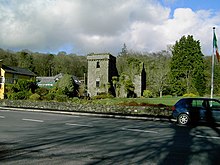User:Marthad99/sandbox
Introduction
[edit]Elizabeth Cronin was a singer/songwriter who specialised in Irish traditional music. Born in 1879 in West Cork and died in 1956 [1].

Early Life
[edit]Elizabeth Cronin, who was nicknamed ‘Bess’ [2], and later ‘The Muskerry Queen of Song’ [3] was born on 30th May 1879 in West Cork [4]. Cronin was the eldest daughter of Maighréad Ní Thuama and Seán ‘Máistir’ Ó hIarlaithe, who was a village headmaster in a school of Barr d’Ínse (which is why he is ‘Máistir), in the Fuithirí area of West Cork, near the Cork-Kerry border [5]. Bess had five other siblings, four sisters: Mary Anne (b. 1882), Johanna (b. 1885), Nora (b. 1890) and Ellie (b. 1891), one brother: Tom (b. 1888) and two half-brothers: Dan and Tim who her father had in his first marriage [6].
Cronin remained in the Baile Bhuirne area her whole life. She spent her teenage years on her uncle, Tomás Ó hIarfhlaithe (Tomás Bheirty) and his wife’s (who was a sister of Bess’s mother) farm nearby. They were both childless [7].
It was during these early years where she learned many songs and stories from her mother as well as on her uncle and aunt’s farm, as many servants came and went for periods of five to six months. Cousins and friends would have also passed on songs to Bess over the years [8]. Bess recalls the story of how she learned Mo Mhúirín Bán. She was sleeping in bed and was woken by a noise that she thought was a ghost. She soon realised it was the sound of butter being churned. An elderly neighbour was churning butter to help her mother and the old woman sang songs through the night while they were at work. Bess joined them and learned the song from the women, as well as many more, and knew them all by morning [9].
Due to Bess’s father being a teacher and her grandfather and uncle having a big interest in books, meant that she was exposed to literature and the written word more than most would have been at the time. [10].
Bess was a fluent native Irish speaker her whole life, as were her entire family and they promoted the Irish language as much as possible [11].
After she married her husband Seán Ó Croinin, she moved to Carraig an Adhmaid, Ballmakeery to ‘The Old Plantation’ which was known as the Cronin family farm [12].

- ^ The Irish Times (19/12/2000). "The Muskerry Queen of Song". The Irish Times.
{{cite news}}: Check date values in:|date=(help) - ^ The Irish Times (19/12/2000). "The Muskerry Queen of Song". The Irish Times.
{{cite news}}: Check date values in:|date=(help) - ^ The Irish Times (19/12/2000). "The Muskerry Queen of Song". The Irish Times.
{{cite news}}: Check date values in:|date=(help) - ^ Ó Cróinín, Dáibhí (2000). The Songs of Elizabeth Cronin, Irish Traditional Singer. Dublin: Four Courts Press.
- ^ Ó Cróinín, Dáibhí (2000). The Songs of Elizabeth Cronin, Irish Traditional Singer. Dublin: Four Courts Press.
- ^ Ó Cróinín, Dáibhí (2000). The Songs of Elizabeth Cronin, Irish Traditional Singer. Dublin: Four Courts Press.
- ^ Ó Cróinín, Dáibhí (2000). The Songs of Elizabeth Cronin, Irish Traditional Singer. Dublin: Four Courts Press.
- ^ Ó Cróinín, Dáibhí (2000). The Songs of Elizabeth Cronin, Irish Traditional Singer. Dublin: Four Courts Press.
- ^ Ó Cróinín, Dáibhí (2000). The Songs of Elizabeth Cronin, Irish Traditional Singer. Dublin: Four Courts Press.
- ^ Ó Cróinín, Dáibhí (2000). The Songs of Elizabeth Cronin, Irish Traditional Singer. Dublin: Four Courts Press.
- ^ Russell, Ian (2003). "Reviewed work: The Songs of Elizabeth Cronin, Irish Traditional Singer". Folk Music Journal. 8 (3): 372-374.
- ^ The Irish Times (19/12/2000). "The Muskerry Queen of Song". The Irish Times.
{{cite news}}: Check date values in:|date=(help)

